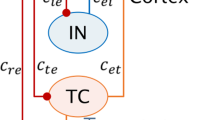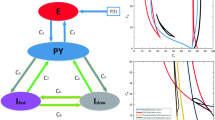Abstract
Waveform transitions have high correlation to spike wave discharges and polyspike wave discharges in seizure dynamics. This research adopts nonlinear dynamics to study the waveform transitions in a cerebral thalamo-coritcal neural network subjected to a square sensory control via discretization and mappings. The continuous non-smooth network outputs are discretized to establish implicit mapping chains or loops for stable and unstable waveform solutions. Bifurcation trees of period-1 to period-2 waveforms as well as independent bifurcation tree of period-3 to period-6 waveforms are obtained theoretically. The independent bifurcation tree should be taken much care during the control since it coexists with global stable waveforms but contains more spikes. Stability and bifurcations of the nonlinear waveform transitions are predicted by eigenvalue analysis of the discretized model. The transient process from unstable waveform to stable waveform is illustrated. The spike adding and period-doubling phenomenon are presented for illustration of the network response after control. The dominant frequency components and the detailed quantity levels of the corresponding amplitudes are exhibited in the harmonic spectrums which can be implemented to controller design for reduction and elimination of the absence seizures. This research presents new perspectives for the waveform transitions and provides theories and data for seizure prediction and regulation.
















Similar content being viewed by others
Data availability
The datasets generated during and/or analyzed during the current study are available from the corresponding author on reasonable request.
References
Abbasova KR, Chepurnov SA, Chepurnova NE, Van Luijtelaar G (2010) The role of perioral afferentation in the occurrenceof spike-wave discharges in the WAG/Rij modelof absence epilepsy. Brain Res 1366:257–262
Amari S (1977) Dynamics of pattern formation in lateral-inhibition type neural fields. Biol Cybern 27(2):77–87
Chen MM, Guo DQ, Wang TB et al (2014) Bidirectional control of absence seizures by the basal ganglia: a computational evidence. PLoS Comput Biol 10(3):e1003495
Chen MM, Guo DQ, Li M et al (2015) Critical roles of the direct GABAergic pallidocortical pathway in controlling absence seizures. PLoS Comput Biol 11(10):e1004539
Chen MM, Zhu YJ, Yu RP et al (2021) Insights on the role of external globus pallidus in controlling absence seizures. Neural Netw 135(2021):78–90
Egorov NM, Sysoev IV, Ponomarenko VI, Sysoeva MV (2022) Complex regimes in electronic neuron-like oscillators with sigmoid coupling. Chaos Solitons Fractals 160:112171
Ersoz EK, Modolo J, Bartolomei F, Wendling F (2020) Neural mass modeling of slow-fast dynamics of seizure initiation and abortion. PLoS Comput Biol 16(11):e1008430
Fan D, Yang Z, Yang C, Wang Q, Luan G (2021) Clinically localized seizure focus maybe not exactly the position of abating seizures: a computational evidence. Nonlinear Dyn 105:1773–1789
http://www.jiankangle.com/mhealth/dp/8aaf510c581f3bb50158296f6d9d00de, 2016
Jedynak M, Pons AJ, Garcia-Ojalvo J (2018) Collective excitability in a mesoscopic neuronal model of epileptic activity. Phys Rev E 97(1):012204
Liu S, Wang Q (2017) Transition dynamics of generalized multiple epileptic seizures associated with thalamic reticular nucleus excitability: a computational study. Commun Nonlinear Sci Numer Simul 52(11):203–213
Luo ACJ (2015) Periodic flows to chaos based on discrete implicit mappings of continuous nonlinear systems. Int J Bifurc Chaos 25(3):1550044
Medvedeva TM, Lüttjohann AK, Sysoeva MV, van Luijtelaar G, Sysoev IV (2020) Estimating complexity of spike-wave discharges with largest Lyapunov exponent in computational models and experimental data. AIMS Biophys 7(2):65–75
Qian M, Zhang Z, Zhong G, Bo C (2022) A novel nonsingular integral terminal sliding mode control scheme in epilepsy treatment. Trans Inst Meas Control 44(6):1194–1204
Shen Z et al (2021) Control and analysis of epilepsy waveforms in a disinhibition model of cortex network. Nonlinear Dyn 104:2063–2079
Sinha N, Wang Y, Dauwels J, Kaiser M, Thesen T, Forsyth R, Taylor PN (2019) Computer modelling of connectivity change suggests epileptogenesis mechanisms in idiopathic generalised epilepsy. NeuroImage Clin 21:101655
Tabatabaee S, Bahrami F, Janahmadi M (2021) The critical modulatory role of spiny stellate cells in seizure onset based on dynamic analysis of a neural mass model. Front Neurosci 15:743720
Taylor PN, Baier G (2011) A spatially extended model for macroscopic spike-wave discharges. J Comput Neurosci 31(3):679–684
Taylor PN, Wang Y, Goodfellow M, Dauwels J, Baier G (2014) A computational study of stimulus driven epileptic seizure abatement. PLoS ONE 9(12):e114316
Taylor PN, Baier G, Cash SS, Dauwels J, Wang Y (2013) A model of stimulus induced epileptic spike-wave discharges. In: 2013 IEEE symposium on IEEE computational intelligence, cognitive algorithms, mind, and brain (CCMB)
van Luijtelaar G, Lüttjohann A, Makarov VV, Maksimenko VA, Koronovskii AA, Hramov AE (2016) Methods of automated absence seizure detection, interference by stimulation, and possibilities for prediction in genetic absence models. J Neurosci Methods 260:144–158
Xu Y, Chen Z, Luo AC (2019) On bifurcation trees of period-1 to period-2 motions in a nonlinear Jeffcott rotor system. Int J Mech Sci 160(9):429–450
Yan L et al (2020) Control analysis of electrical stimulation for epilepsy waveforms in a thalamocortical network. J Theor Biol 504:110391
Zhang HH et al (2017) Seizures dynamics in a neural field model of cortical-thalamic circuitry. Sci China: Technol Sci 60(7):11
Zhang L, Wang Q, Baier G (2020) Spontaneous transitions to focal-onset epileptic seizures: a dynamical study. Chaos 30(10):103114
Zhao JY, Wang QY (2021) The dynamical role of electromagnetic induction in epilepsy seizures: a double-edged sword. Nonlinear Dyn 206:975–988
Acknowledgements
This work is supported by the National Nature Science Foundation of China (Grant No. 12132012, 11972275 and 12102319) and the Fundamental Research Funds for the Central Universities (Grant No. xzy012021004).
Author information
Authors and Affiliations
Corresponding author
Additional information
Publisher's Note
Springer Nature remains neutral with regard to jurisdictional claims in published maps and institutional affiliations.
Rights and permissions
Springer Nature or its licensor (e.g. a society or other partner) holds exclusive rights to this article under a publishing agreement with the author(s) or other rightsholder(s); author self-archiving of the accepted manuscript version of this article is solely governed by the terms of such publishing agreement and applicable law.
About this article
Cite this article
Xu, Y., Wu, Y. Dynamic prediction of nonlinear waveform transitions in a thalamo-cortical neural network under a square sensory control. Cogn Neurodyn (2024). https://doi.org/10.1007/s11571-023-10060-2
Received:
Revised:
Accepted:
Published:
DOI: https://doi.org/10.1007/s11571-023-10060-2




